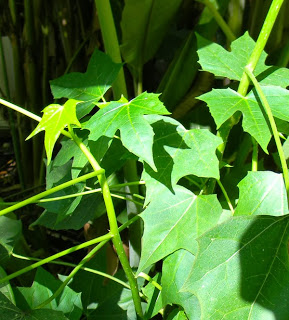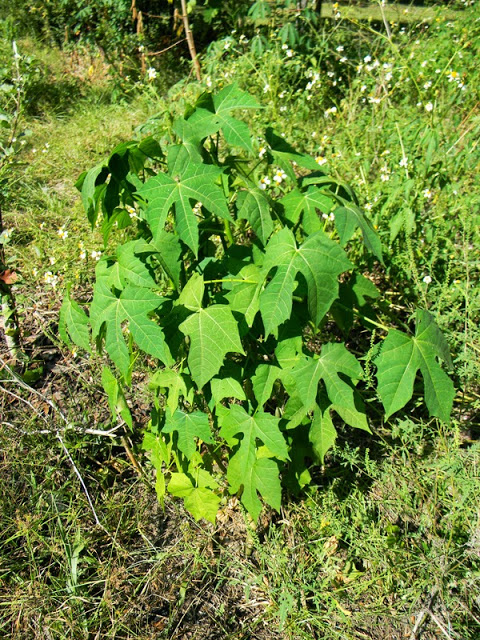Growing chaya in Florida is a no-brainer!
 Greens aren’t all that interesting to me. That doesn’t mean I cut them out of my life… but they’re not as exciting as big piles of roots or amazing homemade grits.
Greens aren’t all that interesting to me. That doesn’t mean I cut them out of my life… but they’re not as exciting as big piles of roots or amazing homemade grits.
Some greens are better than others, of course.
For instance, I firmly stand by the mathematical postulate that mustard greens > collards.
Moringa leaves are good in soups. Bidens alba greens are fine in stir-fries… and turnip greens are about as interesting to me as the 1974 Bowling Championships.
Yet there is a green I find quite enjoyable. So good, in fact, that I will sometimes cook up a pot and eat them as a meal. That green, as you’ve hopefully guessed from my title, is chaya. I think the flavor is similar to a mild and sweet broccoli. It has a nice chewiness to the cooked leaves I also find enjoyable.
Chaya is in the same wild, wonderful, beautiful and often toxic family as cassava. It also contains high levels of cyanide, so you need to take care not to eat it raw, even if you want to. Just don’t. Stop. Put it down. NO!
Boil leaves for 20 minutes, then enjoy them. They’re apparently ridiculously good for you and full of vitamins, which makes sense to me since they taste hearty and delicious.
Growing chaya in Florida is a cinch if you can find cuttings. Cuttings root in a month or so when it’s warm. Just stick them in moist soil and wait. They’re not as fast as cassava but they’ll usually take.
I’ve seen chaya wild down in South Florida, but in the northern half of the state you’re not likely to come across it. Where I live it freezes to the ground every winter but will usually return from the roots and rapidly shoot for the sky. Once you get a couple plants, it’s easy to make more.
 |
| A young chaya bush. This one has been harvested multiple times. |
Bugs don’t seem to bother my chaya plants (CYANIDE!) and they grow decently even in poor soil. I’ve planted them in full sun and in almost full shade and they’ve lived in both places, though the ones grown in shade are thin and leggy.
You can buy chaya cuttings here.
Grab some chaya, tuck a few into your yard… and you’ll have great perennial greens for years to come. This plant’s a winner.
SPUDOMETER RATING:
4 Spuds
Name: Chaya, tree spinach
Latin Name: Cnidoscolus aconitifolius
Type: Perennial shrub
Size: Can grow to over 15′.
Nitrogen Fixer: No
Medicinal: No
Cold-hardy: No
Exposure: Full sun/part shade. Sunny is the best.
Part Used: Leaves, tender new shoots
Propagation: Cuttings
Taste: Excellent
Method of preparation: Boil leaves for at least 20 minutes.
Storability: Poor
Ease of growing: Easy
Nutrition: Excellent
Recognizability: Low
Availability: Low



13 comments
No mention of kale. Kale>mustard greens. By the way, about half of my red potatoes came up that I planted maybe a week before you. I'm surprised that many came up. It was just too hot at the time.
Interested…very interested! Where can I find here in florida?
Hi,
DO you know were I can buy Chaya leaves?? I will really appreciate if some one can help me. I’m in MIami/Fort Lauderdale area. EIther if I have to travel a bit a won’t mind.
Please help :(
I bought some last fall at Edible Plant Project in Gainsville, Florida. They might still have some. Their website isn’t always up to date, but if you send them an email they are very helpful! Prices are very reasonable!!! I didn’t plant mine out yet – just kept in the green house for the winter.
Hi,
I need seeds from both species to plant in my garden. Kindly revert to my email.
A couple of questions… where does the cyanide go when you cook Chaya? If it goes into the water, no drinking the pot likker!.. and, no tossing raw Chaya into the soup… or, do I have that wrong?
If the cyanide wards off pests, would Chaya be a good companion for bug magnets like Potatoes, tomatoes, other leafy greens?
And, is 100°F really too hot? Ha, snowflake! Here in SoCal LowDes is doesn’t get UNDER 100 from about 5/15 to 10/15.. year after year. I wonder what the Indians lived on.. cactus and Mesquite beans? Probably why there weren’t very many of them… smarter than us.
Thanks!
It off-gasses with the steam, I believe – the broth is perfectly safe to drink.
Chaya seems to be somewhat allelopathic, meaning it doesn’t always play well with others. It would be worth interplanting as a test, though.
And yeah, the Indians would have planted early or late, I’ll bet, plus hunted both wild game and wild forage. Mesquite and cactus for sure.
Awesome work David! Thanks for your knowledge in writing!
Olá ! Parabéns pelas informações…Aqui no Brasil um coletivo de mulheres camponesas,cultivam e comercializam a chaya .https://www.facebook.com/Emporiodachaya/
I have the wild prickly chaya, which flowers, is beautiful AND edible (and whose leaves look almost identical in shape to papaya. They’re yummy but have a sting, harvest with gloves!) I recently got a cultivated one as pictured, which is still small but since the leaves are less divided I used some to make dolmades (Greek rice-stuffed grape leaves) since I’ve been craving them, but local muscadine leaves are far too tiny! I just steamed them and let them soak in lemon juice before stuffing, they made an awesome free sub for the elusive and pricey jarred grape leaves!
Even tho you aren’t fond of them, would you know of an online pictorial compilation of greens, wild or cultivated, that are grown in SW FL? I have moringa, chaya, sweet potato vines, malabar and a couple other alternate “spinaches” etc., but recently came across a lovely patch of creeping vine on the side of the road that obviously escaped from the garden nearby. Wish I had a picture, but it’s growth habit looks similar to sweet potatoes only more compact and robust, and the leaves are larger, spade-shaped, with red veins. Not even sure it’s edible it’s so pretty, and isn’t flowering, but this northerner would love to be more knowledgeable about our food options, especially during the summers here. TIA!
Chaya is amazing. I didn’t even know it was a food crop when I planted loads of it. All I knew it grew well in the region (tropics) was easy to propagate (break off a small branch and stick it in the soil). IT grew fast, could take drought, rain, sun shade, crappy soil, good soil, water logged soil anything. We had a part of land prone to erosion so planted about 50 trees along this area. The root system is really strong and a year after planting, no more erosion.
Then I found out it was a super healthy leaf and began eating it a few times a week along with some guerrilla planting when ever I got the chance
That is awesome. What a cool thing to discover!
HI.. wouldn’t most of the nutrients leech out into the boiling water after 20 minutes of boiling. If so, how nutritious is it really after cooking.
Comments are closed.